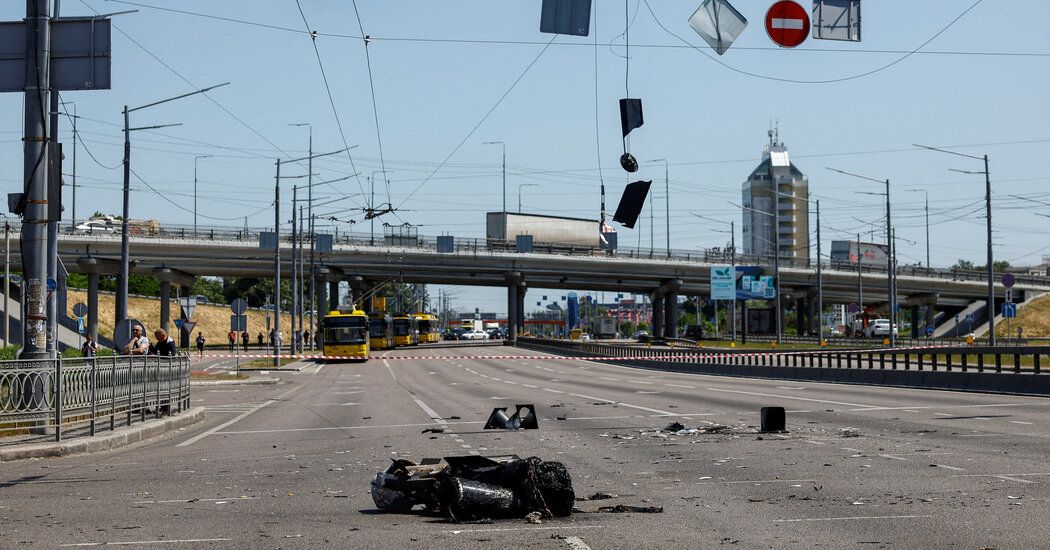Russia Launches a Missile Attack on Kyiv: Live Updates
Officers near part of a missile that landed on a street during a Russian attack on Kyiv on Monday.
KYIV, Ukraine — Frightened pedestrians hurried to get off the streets of Ukraine’s capital and into underground shelters on Monday morning as Russian forces launched a rare daytime missile attack on Kyiv.
Air-raid alarms sounded shortly after 11 a.m. local time, sending parents racing to get their children to safety and hospital workers to take cover in bomb shelters. Powerful explosions echoed around the city within minutes, as Ukrainian air defenses sprung into action.
All 11 missiles directed at Kyiv were shot down, Ukrainian officials said. Falling debris caused some damage in various parts of the city and information about possible casualties was still being clarified, the authorities said.
While Russian forces have launched overnight aerial attacks on Kyiv more than a dozen times this month — including earlier on Monday — the mid-morning assault marked the first daytime air raid in many weeks.
“Just six hours after the night attack” Russia again launched missiles at Kyiv, Serhii Popko, the head of the Kyiv regional military administration, said in a statement. “After long, exclusively nocturnal attacks,” Mr. Popko said, Russian forces “struck a peaceful city during the day, when most of the residents were at work and on the streets.”
Rescue and fire crews were later dispatched to put out fires caused by falling debris that landed on a major roadway in the capital. The Kyiv regional military administration said it was working to clear debris from at least six locations around the city.
Monday marked the 16th time this month that Ukraine’s capital has come under attack. While Russia has deployed attack drones, ballistic missiles and cruise-missiles, the assaults have largely failed to inflict significant damage. With each failed attack, Moscow has been adjusting its tactics to try and inflict maximum damage, according to Ukrainian officials.
Image Patients and medical staff took shelter in the basement of a hospital in Kyiv on Monday. Credit... Nicole Tung for The New York Times
Russian forces have been changing the timings of bombardments, which combination of weapons they use and the trajectories of the missiles and drones, most recently flying them low along riverbeds and through valleys to avoid detection, according to Ukrainian official.
With those adjustments, Russian forces are trying to “confuse and mislead our air defense system,” Yurii Ihnat, a spokesman for Ukraine’s Air Force Command, said in an appearance on national television over the weekend. “It uses the topography of the area to disappear from radars.”
“But as we can see, the Ukrainian air defense is getting stronger and stronger every day,” he said.
On Sunday, Ukrainian air defense teams repelled Russia’s largest drone attack on the city since the start of the war. Less than 18 hours later, another overnight attack followed.
The Ukrainian Air Force said that Russian forces had fired up to 40 cruise missiles and 35 Iranian-made attack drones before dawn on Monday, many directed at the capital. It said 37 of the missiles and 29 of the drones had been shot down.
One missile hit the village of Kivsharivka in northeastern Ukraine’s Kharkiv region, according to the local military administration, which said at least three people were wounded in the attack.
The Russian overnight assault did manage to hit at least one military installation, according to Ukrainian officials, damaging an airfield located in Khmelnytskyi in western Ukraine.
“Five aerial vehicles went out of service,” the Khmelnytskyi Regional Military Administration said in a statement. It said rescue crews were racing to put out fires at a fuel depot and warehouse at the base. “Restoration works also started at the runway,” the administration said.
Hours after those strikes, air alarms sounded again in several regions of Ukraine. Millions across the capital still reeling from the consecutive nights of bombardment watched as air defense missiles launched into the clear blue spring sky.
The residents of Kyiv — a city of 3.6 million people — paused, braced and waited. When the blasts subsided, residents of the capital did as they have done after every attack — posted messages on social media thanking air defense teams, texted their friends and proceeded to go about their business.
Nataliia Novosolova and Tiffany May contributed reporting.
Source: The New York Times


